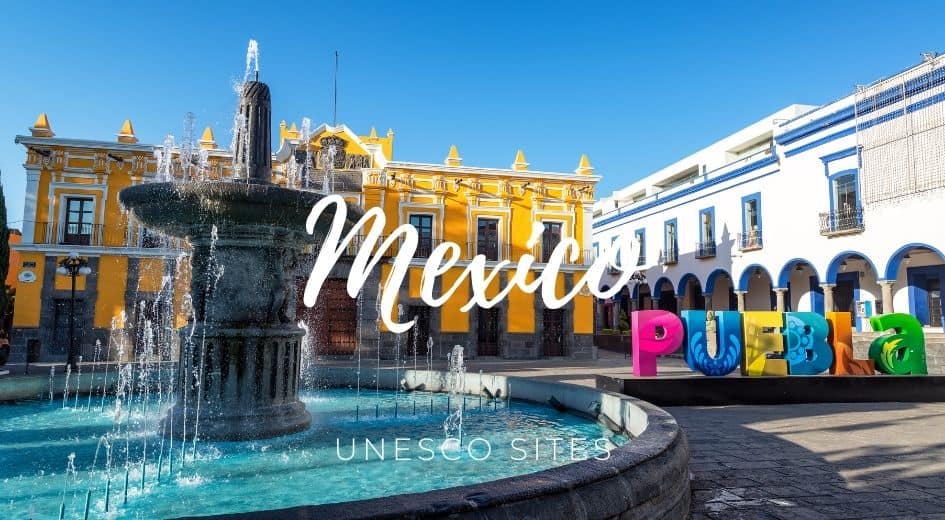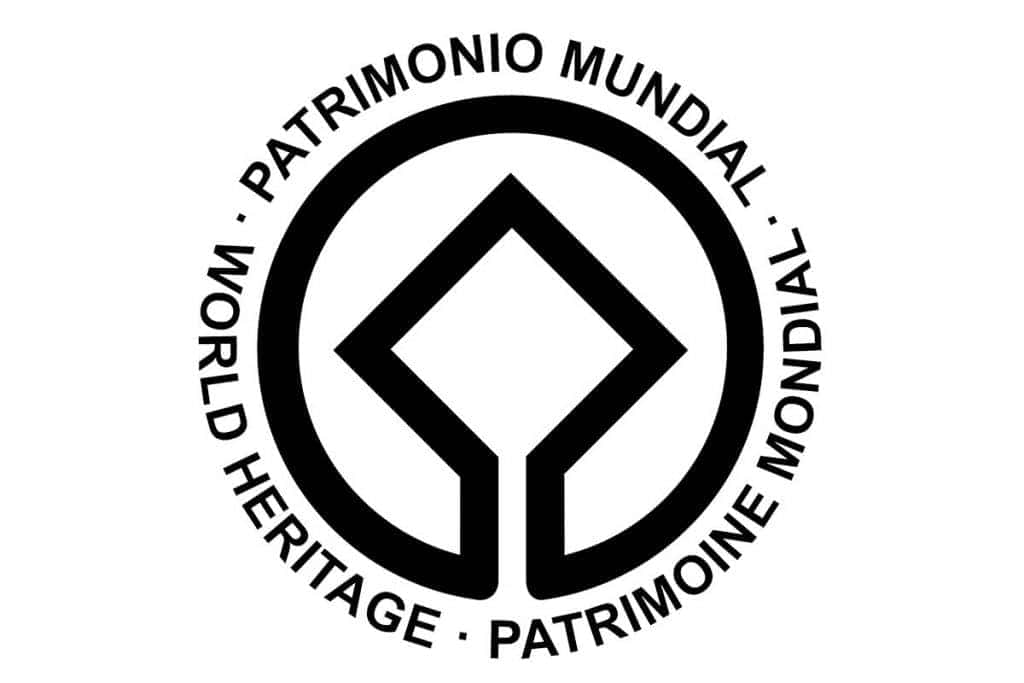Table of Contents


Mexico UNESCO has registered 35 sites on the World Heritage list and 21 on the tentative list.
Some places are so interesting that it’s relevant to keep them for future generations. This is why UNESCO has built a list of crucial classified properties in which superb places stand out for their aesthetic, natural, artistic, or cultural significance.
More than a thousand places are registered as Unesco’s World Heritage worldwide. Due to my interest in visiting World Heritage sites, I compiled the UNESCO list in Mexico and the corresponding map.
Mexico UNESCO list
- Agave Landscape and Ancient Industrial Facilities of Tequila
- Aqueduct of Padre Tembleque Hydraulic System
- Archaeological Monuments Zone of Xochicalco
- Archaeological Zone of Paquimé, Casas Grandes
- Camino Real de Tierra Adentro
- Central University City Campus of the Universidad Nacional Autónoma de México (UNAM)
- Earliest 16th-Century Monasteries on the Slopes of Popocatepetl
- El Tajin, Pre-Hispanic City
- Franciscan Missions in the Sierra Gorda of Querétaro
- Historic Centre of Mexico City and Xochimilco
- Historic Centre of Morelia
- Historic Centre of Oaxaca and Archaeological Site of Monte Albán
- Historic Centre of Puebla
- Historic Centre of Zacatecas
- Historic Fortified Town of Campeche
- Historic Monuments Zone of Querétaro
- Historic Monuments Zone of Tlacotalpan
- Historic Town of Guanajuato and Adjacent Mines
- Hospicio Cabañas, Guadalajara
- Luis Barragán House and Studio
- Pre-Hispanic City and National Park of Palenque
- Pre-Hispanic City of Chichen-Itza
- Pre-Hispanic City of Teotihuacan
- Pre-Hispanic Town of Uxmal
- Prehistoric Caves of Yagul and Mitla in the Central Valley of Oaxaca
- Protective town of San Miguel and the Sanctuary of Jesús Nazareno de Atotonilco
- Rock Paintings of the Sierra de San Francisco
- Archipiélago de Revillagigedo
- El Pinacate and Gran Desierto de Altar Biosphere Reserve
- Islands and Protected Areas of the Gulf of California
- Monarch Butterfly Biosphere Reserve
- Sian Ka’an
- Whale Sanctuary of El Vizcaino
- Ancient Maya City and Protected Tropical Forests of Calakmul, Campeche
- Tehuacán-Cuicatlán Valley: originary habitat of Mesoamerica
Mexico UNESCO Map
Click on the blue pins to view more relevant information about each World Heritage site in Mexico.
Description
- Agave Landscape and Ancient Industrial Facilities of Tequila: A cultural landscape in the western state of Jalisco associated with tequila, a traditional Mexican alcoholic beverage made from the agave plant.
- Aqueduct of Padre Tembleque Hydraulic System: A hydraulic system in central Mexico built in the 16th century to transport water to the city of Mexico (now Mexico City).
- Archaeological Monuments Zone of Xochicalco: An ancient Maya site located in the central state of Morelos that contains well-preserved examples of Maya architecture and sculpture.
- Archaeological Zone of Paquimé, Casas Grandes: An ancient settlement located in the northern state of Chihuahua that reflects the influence of various Mesoamerican and Southwestern cultures on the region’s architecture, art, and social organization.
- Camino Real de Tierra Adentro: A historic road that connected Mexico City with Santa Fe, New Mexico, and played a key role in the cultural and economic exchange between Mexico and the United States.
- Central University City Campus of the Universidad Nacional Autónoma de México (UNAM): A university campus in Mexico City was designed by a group of prominent Mexican architects in the mid-20th century and represented a unique blend of modernist and traditional Mexican architectural styles.
- Earliest 16th-Century Monasteries on the Slopes of Popocatepetl: A collection of monasteries and other religious buildings in central Mexico built in the early 16th century by Franciscan and Dominican friars.
- El Tajin, Pre-Hispanic City: An ancient city in the eastern state of Veracruz that contains well-preserved examples of Mesoamerican architecture and art.
- Franciscan Missions in the Sierra Gorda of Querétaro: A collection of five Franciscan missions in the central state of Querétaro built in the 18th century and reflect a unique blend of European and indigenous architectural styles.
- Historic Centre of Mexico City and Xochimilco: The historic center of Mexico City contains well-preserved examples of Spanish colonial architecture, urban planning, and the Xochimilco canals, which reflect the region’s indigenous heritage.
- Historic Centre of Morelia: The historic center of Morelia, located in the central state of Michoacán, contains well-preserved examples of colonial architecture and urban planning.
- Historic Centre of Oaxaca and Archaeological Site of Monte Albán: The historic center of the city of Oaxaca, located in the southern state of Oaxaca, which contains well-preserved examples of colonial architecture and urban planning, as well as the ancient city of Monte Albán, which was a major center of Zapotec civilization.
- Historic Centre of Puebla: The historic center of Puebla, located in central Mexico, contains well-preserved examples of colonial architecture and urban planning.
- Historic Centre of Zacatecas: The historic center of the city of Zacatecas, located in northern Mexico, contains well-preserved examples of colonial architecture and urban planning.
- Historic Fortified Town of Campeche: A fortified town on the Yucatán Peninsula in southern Mexico reflects the region’s colonial history and strategic importance.
- Historic Monuments Zone of Querétaro: The historic center of Querétaro, located in central Mexico, contains well-preserved examples of colonial architecture and urban planning.
- Historic Monuments Zone of Tlacotalpan: A historic town on the Gulf Coast of Mexico that reflects the region’s unique blend of Spanish, Caribbean, and indigenous cultures.
- Historic Town of Guanajuato and Adjacent Mines: The historic center of Guanajuato, located in central Mexico, contains well-preserved examples of colonial architecture and urban planning, as well as the adjacent silver mines that were a major source of wealth for the region.
- Hospicio Cabañas, Guadalajara: A former hospice and orphanage located in Guadalajara built in the early 19th century and reflected a unique blend of Neoclassical and Mexican architectural styles.
- Luis Barragán House and Studio: The former home and studio of Mexican architect Luis Barragán, located in Mexico City, reflects his innovative approach to modernist architecture and landscape design.
- Pre-Hispanic City and National Park of Palenque: An ancient Maya city located in the rainforests of the southern state of Chiapas that contains well-preserved examples of Maya architecture and sculpture and a diverse range of flora and fauna.
- Pre-Hispanic City of Chichen-Itza: An ancient Maya city on the Yucatán Peninsula with well-preserved examples of Maya architecture and urban planning, including the iconic Temple of Kukulcan.
- Pre-Hispanic City of Teotihuacan: An ancient city in the Valley of Mexico that was a major center of Mesoamerican civilization and contained well-preserved examples of monumental architecture, including the Pyramid of the Sun and the Pyramid of the Moon.
- Pre-Hispanic Town of Uxmal: An ancient Maya city in the Yucatán Peninsula with well-preserved examples of Maya architecture and sculpture, including the Governor’s Palace and the Pyramid of the Magician.
- Prehistoric Caves of Yagul and Mitla in the Central Valley of Oaxaca: A series of prehistoric caves in the central state of Oaxaca contain well-preserved examples of rock art and other evidence of early human habitation in the region.
- Protective town of San Miguel and the Sanctuary of Jesús Nazareno de Atotonilco: The historic center of the town of San Miguel de Allende, located in central Mexico, which contains well-preserved examples of colonial architecture and urban planning, as well as the Sanctuary of Jesús Nazareno de Atotonilco, a major pilgrimage site.
- Rock Paintings of the Sierra de San Francisco: A collection of prehistoric rock art in the Baja California Peninsula that reflects the artistic and cultural traditions of the region’s indigenous peoples.
- Archipiélago de Revillagigedo: A group of four volcanic islands in the Pacific Ocean home to a unique marine ecosystem and a diverse range of endemic species.
- El Pinacate and Gran Desierto de Altar Biosphere Reserve: A protected area located in the northern state of Sonora that contains a diverse range of ecosystems, including deserts, volcanic landscapes, and wetlands.
- Islands and Protected Areas of the Gulf of California: A collection of islands and marine protected areas home to a diverse range of marine life, including several endemic species.
- Monarch Butterfly Biosphere Reserve: A protected area in central Mexico that serves as the winter home for millions of monarch butterflies migrating from Canada and the United States.
- Sian Ka’an: A biosphere reserve located on the Yucatán Peninsula that contains a diverse range of ecosystems, including tropical forests, wetlands, and coral reefs, as well as several archaeological sites that reflect the region’s Maya and colonial history.
- Whale Sanctuary of El Vizcaino: A protected area on the Pacific coast of Mexico that serves as the breeding and feeding grounds for several species of whales, including the gray whale.
- Ancient Maya City and Protected Tropical Forests of Calakmul, Campeche: An ancient Maya city located in the southern state of Campeche that contains well-preserved examples of Maya architecture and sculpture, as well as a vast expanse of tropical forests that are home to a diverse range of flora and fauna.
- Tehuacán-Cuicatlán Valley: original habitat of Mesoamerica: A valley in central Mexico recognized as the birthplace of Mesoamerican agriculture and contained a diverse range of plant and animal species as well-preserved examples of ancient rock art and other evidence of human habitation dating back thousands of years.
UNESCO World Heritage Sites in Mexico have protected places for their cultural and natural importance.
Sites on the Tentative List
- Chapultepec Woods, Hill and Castle
- Historic Town of Alamos
- Church of Santa Prisca and its Surroundings
- Pre-Hispanic City of Cantona
- Great City of Chicomostoc-La Quemada
- Historic Town of San Sebastián del Oeste
- Diego Rivera and Frida Kahlo’s Home-Study Museum
- Vallée des Cierges
- Aire de protection de la flore et de la faune Cuatrociénegas
- Historical Town The Royal of the Eleven Thousand Virgins of Cosala in Sinaloa
- Huichol Route through the sacred sites to Huiricuta (Tatehuari Huajuye)
- Région Lacan-Tún – Usumacinta
- Réserve de la Biosphère Banco Chinchorro
- Tecoaque
- Cuetzalan and its Historical, Cultural and Natural Surrounding
- Historical city of Izamal (Izamal, Mayan continuity in an Historical City)
- Los Petenes-Ría Celestún
- Las Pozas, Xilitla
- El Arco del Tiempo del Río La Venta
- Ring of cenotes of Chicxulub Crater, Yucatan
- Las Labradas, Sinalao archaeological site


